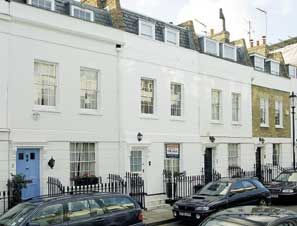Financial footholds in London
Moving to the country doesn't necessarily mean taking all toes out of the London property market with the launch of a new fund


You've decided to throw in the towel and move to the country. Surely a change that is good for the soul, but what about the wallet? If you're moving from 'Prime Central London (PCL)' defined by Savills as Mayfair, Belgravia, Knightsbridge, Chelsea, Notting Hill, Holland Park, Kensington, Hampstead, St John's Wood and Regent's Park you could be letting go of one of the most lucrative investments available. Savills' latest note on the market says that, in the first quarter of 2007 alone, this peak area increased in value by 9%. So-called 'trophy properties' those over £5 million are growing at an annual rate of 50%. All is not lost, however. For a £10,000 investment, it is possible to maintain exposure to this valuable residential area without the normal hassle of owning and letting a residential property. The Prime London Capital Fund, run by D&G Investment Management (D&CIM) (www.dngim.com) is a new fund that allows you access to this lucrative property market. It's regulated, open-ended (you can get in and out on a quarterly basis), has a target return of 9% per annum, and you can invest your Self-Invested Personal Pension in it. It invests in the most liquid part of the PCL housing market that is, properties over the £1 million mark which are improved and then let to high-quality, corporate tenants. But if you are leaving town to buy a home elsewhere in the UK, aren't you at risk of over-exposing yourself to the UK property market by maintaining a foothold in London? In fact, the correlation between PCL prices and the rest of the UK is under 10%. 'Prime Central London has outperformed mainstream London and the rest of the UK for 23 years,' says Liam Bailey of Knight Frank. 'Although UK house prices have increased by 490%, prices of prime property have risen by 680% 'So what's behind this growth story? In the UK, the general population is getting better off over time, but the top proportion of households is getting much richer, much faster than the rest of us, and these consumers are concentrated in the capital. Another aspect of the market is that an increasing share of property is being taken by foreign buyers. Mr Bailey estimates that more than half of all buyers at the top end of the market are foreign rich Indian, Russian and Chinese buyers being the latest to join the property hunt. They're attracted by the UK's tax scheme, which allows foreign residents to be taxed only on what they actually brought into the UK regardless of how much money they've earned overseas. A glance at The Sunday Times Rich List confirms the above story. Only one out of five of Britain's richest people was born in the UK. Where do they want to live? 'Knightsbridge will always be Knightsbridge,' says Stephen Tucker, director at financial advisors The Fry Group. 'Having said that, the very rich never really live anywhere. But if they're in London six weeks a year, they'd rather have their own home than stay in a hotel.' So if you aren't on The Sunday Times Rich List, even buying to let in Prime Central London may tie up more capital than you have to hand. That's where the Prime London Capital Fund comes in. It's the only one of its kind according to D&GIM's CEO Stephen Yorke, this is because 'the big institutions could not devote the time we do to ensure that only the best stock is acquired. The only way to make good money from all property, but especially PCL property, is to cherry-pick the best stock and leave the rest alone. It's incredibly labour-intensive and we consistently look at 30 to 40 properties before we offer on one. This is an imperfect market, where not everyone has access to the same stock and information. Our investors benefit from that imperfection because we see stock that isn't widely marketed, whereas normal buyers would not.' So what's the catch? Central London is much faster to react to economic downturns such the burst of the dotcom bubble; it fell faster than the rest of the market, but recovered more quickly as well. Mr Yorke is quick to point out, however, that on a total return basis (including the money you get back from rent, not just the capital value of the property), since 1973, there has only been one negative year for this market. All the usual warnings about property still apply there are doomsayers predicting the end of the housing boom in the UK. 'Will there be tears before bedtime in the property market?' asks Mr Tucker. 'Of course, but as part of a well-managed portfolio over a five-to-10 year period, this asset is likely to shine. As an investor, you're getting hassle-free exposure to some of the best addresses on the planet. After all, Harrods isn't going anywhere, is it?'
Sign up for the Country Life Newsletter
Exquisite houses, the beauty of Nature, and how to get the most from your life, straight to your inbox.
Country Life is unlike any other magazine: the only glossy weekly on the newsstand and the only magazine that has been guest-edited by HRH The King not once, but twice. It is a celebration of modern rural life and all its diverse joys and pleasures — that was first published in Queen Victoria's Diamond Jubilee year. Our eclectic mixture of witty and informative content — from the most up-to-date property news and commentary and a coveted glimpse inside some of the UK's best houses and gardens, to gardening, the arts and interior design, written by experts in their field — still cannot be found in print or online, anywhere else.
-
 A well-connected rural playground with 23 acres on the edge of the South Downs National Park
A well-connected rural playground with 23 acres on the edge of the South Downs National ParkOld House Farm is an impressive family home with a wealth of amenities that would inspire any rural passion.
By Arabella Youens Published
-
 The UK gets its first ‘European stork village’ — and it's in West Sussex
The UK gets its first ‘European stork village’ — and it's in West SussexAlthough the mortality rate among white storks can be up to 90%, the future looks rosy for breeding pairs in southern England.
By Rosie Paterson Published

